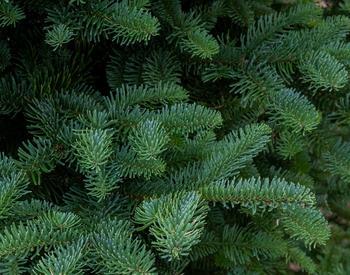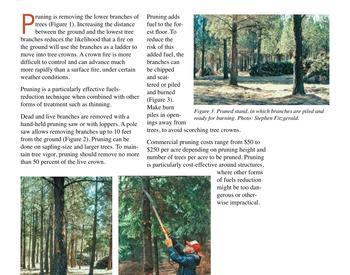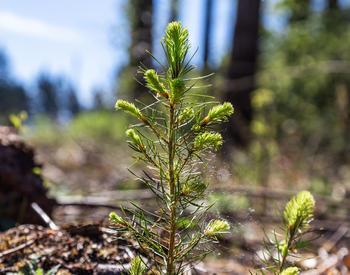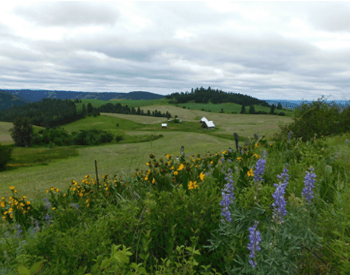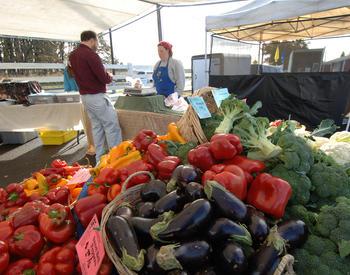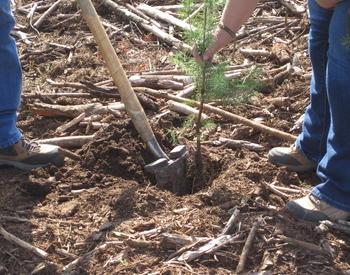A year can make a big difference in the survival rates of young trees.
Hot, dry conditions in 2016–18 resulted in higher than normal losses of Christmas tree seedlings in newly planted fields. This was especially true in noble fir plantings, where mortality rates soared.
Seedling survival was much better in 2019, especially considering that most Christmas tree plantations are dryland farmed, without irrigation.
In 2018, we established a research trial to test possible options for increasing survival rates. We evaluated additional watering, shading and the use of root-growth stimulators and anti-transpirants to aid in seedling survivability. Trial results showed that only supplemental water and shade improved survival.
We set out in 2019 to try a few new options and reevaluate prior strategies that showed potential. Our 2019 trial was set up in two Christmas tree plantations in the Molalla area. Each site was planted with 2-year old noble fir.
Site 1
- 865 ft elevation
- 1,120 trees planted April 25
- Jory silty clay loam, previously planted with large Douglas-fir. Ground prepped prior to planting.
- Atrazine herbicide applied within one week of planting
Site 2
- 1,310 ft. elevation
- 840 trees planted May 1
- Molalla cobbly loam, prior Christmas tree rotation
- Glystar Original applied during the growing season
Working closely with us, the growers machine-planted Site 2 as usual while incorporating the pre-plant applications.
Pre-plant treatments included:
- Dynahume SW: a 10% humic acid/1% soluble potash crop enhancement product as a root dip. (Site 1)
- B-1 root dip, and/or Solid Rain: a potassium polyacrylate product placed into the planting hole. (Site 2)
Post-plant treatments included:
- Stomaboost Supreme (7-17-4 liquid foliar fertilizer) applied approximately six weeks after planting. (Site 1)
- Dynahume SW foliar spray applied about six weeks after planting. (Site 1)
- Physical shades and mulch treatments (both sites)
All treatments were replicated and randomized, and we included an untreated control group for comparison. We placed pendant temperature monitors on trees representing each treatment at both sites. On these same trees, soil moisture probes were placed at root depth to get a picture of the wetting and drying of the soil throughout the summer.
Both years, trials took place during the same time frame, May to October. The growing season of 2018 was considerably drier and proved to be a good summer to conduct a mortality trial. The 2019 trial period had much more precipitation. We did not measure precipitation at each specific site, but data from NOAA collected from weather sites nearby show nearly 6 additional inches of rain for the area in the same time period in 2019.
Site observations
- Site 1: Overall survival on the untreated seedings in 2019 was 80%. On the same site in 2018, the survival rate was 64%. The use of physical shades increased tree survival in both years. The addition of the wood mulch also showed an increase in survivability. None of the root dips or foliar sprays provided an increase in survivability.
- Site 2: Overall survival on the untreated trees was 90% in 2019. On this site, shades and mulch did not improve seedling survival. However, the use of pre-plant additives B-1 root dip and Solid Rain provided an additional 5%-7% rate of survival of seedlings.
Discussion
Looking at the big picture, the added rainfall and reduced temperature patterns of 2019 provided a huge improvement in seedling survival across the Pacific Northwest. Trees need water.
The more subtle differences between our two sites are more difficult to sort out. Research projects don’t always provide the answers to the initial questions, and often bring up more questions. That is the inherent nature of research! Points to ponder regarding these findings include site differences, especially weed pressure. Site 1 seedlings had high weed pressure. This likely is the reason for the 15% lower overall seedling survival rating. In contrast, site 2 had low weed pressure, probably slightly more rainfall and high survival rates. We would need additional studies to reach any conclusions on the benefits of B-1 and Solid Rain. Yet, we found that the addition of these treatments in 2019 helped at site 2. At site 1, shade and mulch improved survival.
In the real world, we plant our seedlings without knowing how hot or dry the season to come will be. In a hot-dry year like 2018, adding supplemental water likely is the best seedling survival treatment, followed by shade, mulch and weed control (to preserve water). In a mild year like 2019, supplemental watering is not needed, but some of the pre-plant dips, shade and mulch may help provide marginally better survival.
¡Use los pesticidas con seguridad!
- Póngase ropa de protección y equipo de seguridad según las recomendaciones de la etiqueta. Báñese después de cada uso.
- Lea la etiqueta del pesticida—aunque lo haya usado antes. Siga al pie de la letra las indicaciones de la etiqueta (y cualquiera otra indicación que Ud. tenga).
- Tenga precaución al aplicar los pesticidas. Conozca su responsabilidad legal como aplicador de pesticidas. Usted puede ser responsable de heridas o daños resultantes del uso de un pesticida.

